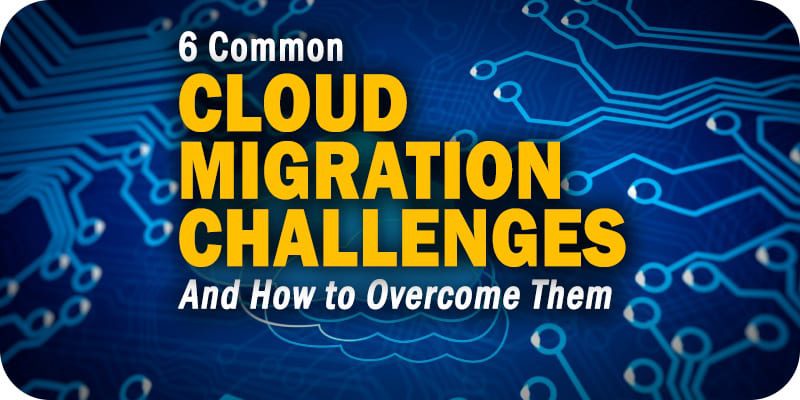6 Common Cloud Migration Challenges (And How to Overcome Them)


Solutions Reviews lists six common cloud migration challenges that businesses are likely to face – and how you can overcome them.
Is your business considering moving to the cloud? Cloud computing has exploded over the past decade as the number of cloud providers and solutions continues to increase. Studies consistently find that businesses are adopting the cloud into their infrastructure at a feverish rate. Before your enterprise makes the jump, however, you need to develop a strategy for migrating to the cloud. That includes figuring out how to overcome the challenges associated with cloud migration.
Successfully migrating to the cloud requires a lot of attention from your enterprise. If your business isn’t prepared to deal with the challenges of cloud migration, then it could be costly and dangerous for you and your data. However, knowing about these challenges and how to deal with them before you start your cloud journey will give you a big advantage. Below, we’ve listed six common cloud migration challenges that businesses face – and how you can overcome them.
Planning a cloud migration strategy
IT professionals know that you can’t just blindly adopt a new technology into your infrastructure without a solid strategy in place. The cloud is no exception to this rule; planning out your migration before you make the jump to the cloud is an essential part of the process. This doesn’t just include choosing the right cloud provider for your business, however. You need to factor in cost analysis, projected downtime, employee training, and an estimated time to complete the migration. That last part is a key element because fully migrating to the cloud can take a long time (potentially up to several months) depending on the size of your business and how much data you’re moving to the cloud.
Breaking down your cloud migration into stages
The worst thing you could possibly do when it comes to cloud migration is try to move everything onto the cloud at once. While businesses are eager to migrate their data to the cloud, they need to know which data should be moved over first. A good general practice is to start migrating non-essential or redundant data first. Because you’ll still be testing the waters when you start the migration process, it’s possible that your staff might make an error that could erase, corrupt, or unsecure your data. You don’t want to risk that happening to your business-critical or sensitive data, especially if you need to maintain compliance.
The financial cost of cloud migration
Moving to the cloud can be costly, especially if you don’t project the potential financial impact beforehand. While the cloud is often cost-effective in the long term, cloud migration might be expensive upfront depending on how much data you plan to move. This financial cost shouldn’t just factor in the cost of using the cloud solutions, however. You also need to consider the cost of training employees on the new technology and the cost of rewriting or replacing data to be compatible with the cloud architecture.
Cloud security questions
Security is the number one barrier that prevents businesses from adopting the cloud, and for good reason. It’s always a smart approach to consider security as a top priority, especially when integrating new technologies. When you use cloud solutions, you’re essentially asking another party to hold onto your data for you. If that party is trustworthy (and demonstrates this trustworthiness), then your cloud operations will flourish; if not, they’ll crash and burn. Specifically, you should be made aware of your cloud provider’s security practices. You should know where your data will be stored, how the provider encrypts your incoming and outgoing data, and what regulations the provider is compliant with.
Training employees on your cloud solutions
Whenever you introduce a new technology to your business, you need to ensure that everyone who uses that technology is on board. You can’t assume that everybody will be able to understand a new solution on their own. Take some time to get your employees up to speed on the cloud and the solutions your business is integrating. It will save a lot of headaches in the long run than if you just dump the new technology onto them.
Preventing cloud vendor lock-in
Even if your initial expectations for a cloud vendor are positive, you may find after starting the cloud migration process that your vendor isn’t working for you. Vendor lock-in is a common problem for adopters of cloud technology; because the process of moving data from one cloud to another is a long, costly process, most businesses will simply stick to one vendor even if it isn’t the best fit for them. When you’re choosing cloud providers, it’s important to consider what your cloud goals are and which vendor is the most likely to help you achieve them. You should also look for service-level agreements (SLAs) that contain information on what the vendor will do to help you in case you want to stop using their cloud services.
Running a cloud environment and need help managing the cloud services you use? Our MSP Buyer’s Guide contains profiles on the top cloud MSP vendors for AWS, Azure, and Google Cloud, as well as questions you should ask providers and yourself before buying. We also offer an MSP Vendor Map that outlines those vendors in a Venn diagram to make it easy for you to select potential providers.
Check us out on Twitter for the latest in Enterprise Cloud news and developments!





















